Blog
Hiking vs. Trekking: Understanding the Key Differences for Outdoor Enthusiasts
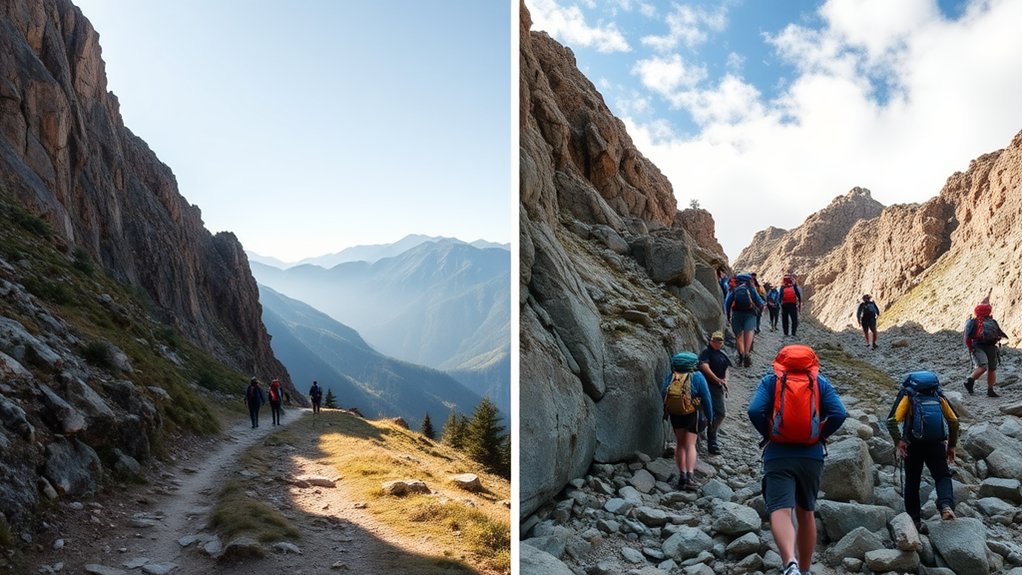
While hiking and trekking both involve outdoor exploration, they differ substantially in scope and demands. You'll find hiking suits shorter adventures on well-maintained trails, typically lasting a few hours to a day, with basic gear requirements and minimal planning. In contrast, trekking takes you deep into remote territories for multiple days or weeks, demanding extensive preparation, specialized equipment, and greater physical endurance. You'll need robust gear, navigation skills, and careful planning for trekking, while hiking requires just comfortable shoes and daytime essentials. Understanding these key differences will help you choose the adventure that matches your experience and goals.
Key Takeaways
- Hiking typically involves short day trips on well-maintained trails, while trekking spans multiple days in remote, challenging terrain.
- Trekking requires extensive planning, permits, and logistics, whereas hiking can be more spontaneous with minimal preparation.
- Essential gear for trekking includes camping equipment and 15kg of supplies, while hiking needs only basic gear and daypack.
- Trekking demands superior physical fitness for 20-50 mile days at high altitudes, unlike hiking's moderate physical requirements.
- Financial commitment for trekking ranges from $2,000-4,500, while hiking requires minimal investment in basic gear and supplies.
The Nature of Adventure
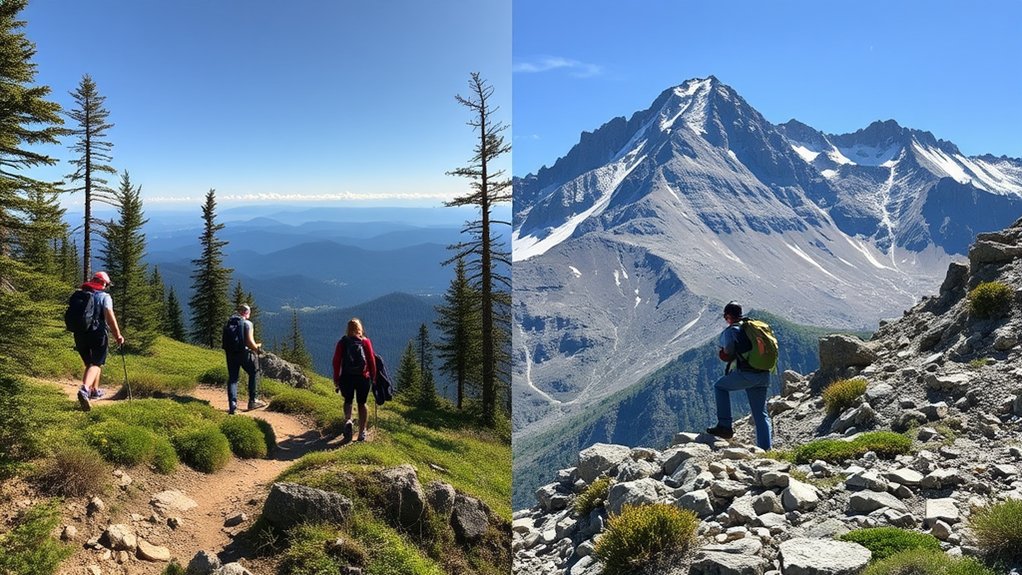
Hiking and trekking offer distinctly different levels of adventure and commitment in the great outdoors. When you choose to go hiking, you're embracing the freedom of shorter adventures that can fit perfectly into your daily life. These outdoor activities typically take place in varying terrain levels, from local woods to suburban trails.
You'll find yourself exploring well-maintained trails for a few hours or perhaps a weekend, allowing you to connect with nature without extensive planning or preparation. Most hiking paths provide benches and picnic spots for moments of rest and leisure. Basic gear like sturdy footwear is essential for a comfortable hiking experience.
Trekking, on the other hand, calls to those seeking a more immersive wilderness experience. You'll venture into remote landscapes for extended periods, often spending weeks or months traversing challenging terrains and diverse environments. The activity requires carrying up to 15 kg of essential gear and supplies. Trekking enthusiasts must demonstrate higher fitness levels to handle the demanding physical challenges.
This deeper form of exploration takes you through high-altitude paths, dense forests, and rugged mountain passes, where each day brings new challenges and discoveries.
The beauty of hiking lies in its accessibility and flexibility – you can hit the trails whenever inspiration strikes. Meanwhile, trekking demands a more significant commitment, as you'll navigate through untamed wilderness, camp under the stars, and rely on your self-sufficiency skills.
Each pursuit offers its own path to freedom, whether you're seeking a brief escape or a transformative journey into the wild.
Time and Planning Needed
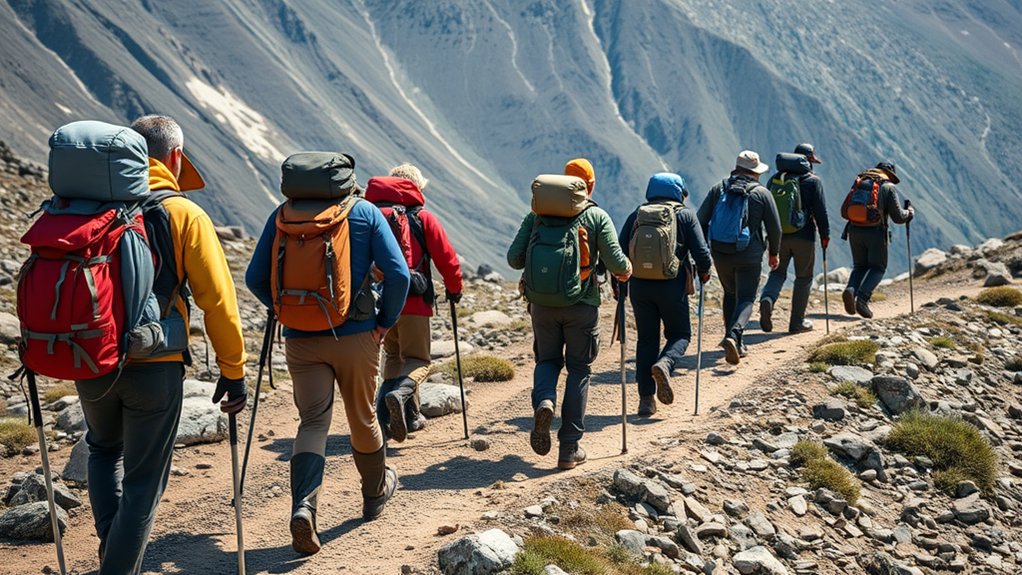
When planning your outdoor adventure, you'll find stark differences in the time commitment and preparation needed for these two activities. Hiking offers you the freedom of spontaneity, typically lasting just a few hours or a day, with minimal planning required.
You'll need only basic gear, comfortable shoes, and a light backpack with essentials. The primary purpose of hiking is often enjoying nature views while maintaining good cardiovascular health. Simply check the weather, inform someone of your plans, and hit the trail.
Trekking demands a more substantial investment of both time and preparation. You're looking at multiple days, weeks, or even months of adventure, requiring careful planning for every aspect of your journey. Those attempting high-altitude treks must follow proper acclimatization guidelines to ensure safety.
You'll need to arrange permits, study routes, and prepare for various weather conditions. Your gear list expands considerably to include camping equipment, specialized clothing, and emergency supplies.
The logistical complexity also differs dramatically. While hiking trails are usually well-maintained and accessible, trekking often takes you into remote areas where self-sufficiency is vital.
You might need guides, special permits, and detailed planning for food and water sources. The costs reflect this difference, with hiking requiring minimal investment while trekking demands more substantial financial commitment.
Physical Demands and Challenges
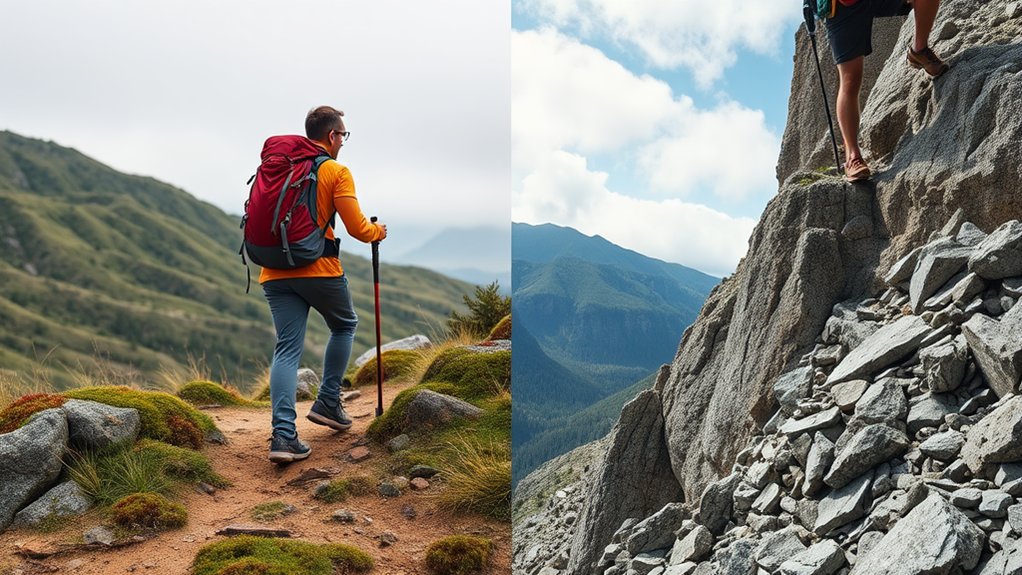
The physical demands of both activities stand worlds apart regarding intensity and endurance requirements. While hiking welcomes adventurers of various fitness levels, trekking calls for a more robust physical foundation.
You'll find hiking trails generally forgiving, with well-maintained paths and moderate terrain that won't push your limits too drastically. Minimal specialized gear is needed for most hiking adventures, making it a more accessible outdoor activity.
Trekking, however, challenges you to step up your game substantially. You'll need to build stamina and strength to handle steep ascents, rugged terrain, and the weight of extensive gear on your back. Daily distances during treks can reach 20 to 50 miles over challenging landscapes.
The physical demands intensify as you navigate through unpredictable conditions at higher elevations, where the air grows thin and each step requires more effort.
Your mental fortitude plays a vital role in both activities, but trekking tests your psychological resilience more intensely. You'll need to maintain focus while traversing narrow paths, adapting to extreme weather conditions, and staying alert for wildlife encounters.
The combination of carrying heavier loads, managing challenging terrain, and maintaining stamina over multiple days makes trekking a much more demanding pursuit than its shorter, lighter cousin.
Exploring Different Landscapes
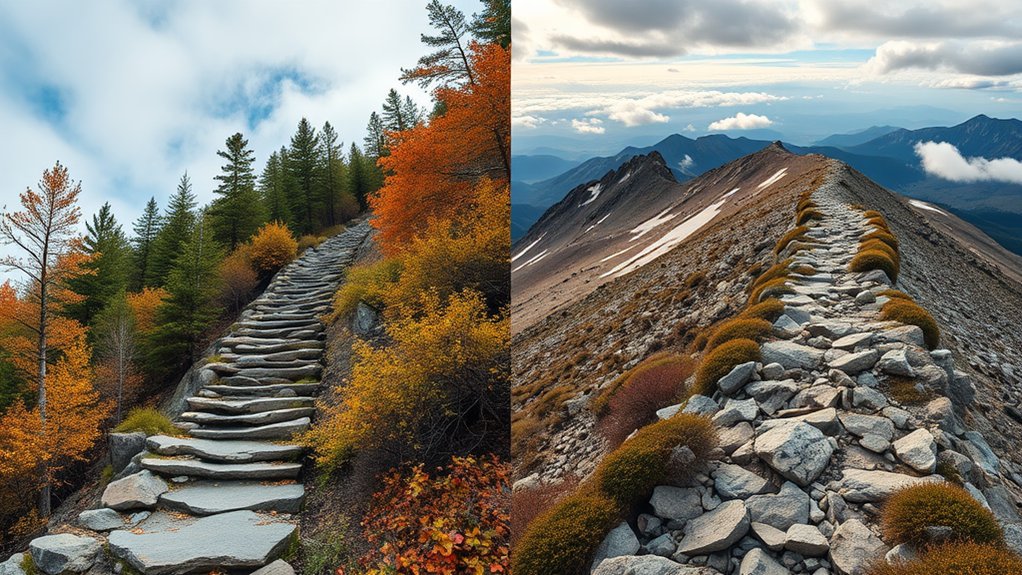
Beyond the physical demands, both activities invite you into remarkably different worlds of natural beauty. While hiking leads you through well-marked trails and maintained paths near civilization, trekking takes you deep into untamed territories where few have ventured.
On hiking trails, you'll find yourself walking through color-coded routes with convenient amenities and clear signage. These paths often loop through local forests or mountainsides, making them perfect for spontaneous adventures when you're seeking a quick escape from urban life. Walking poles are optional but can provide extra stability on rugged sections.
Trekking, however, throws you into a raw, unfiltered wilderness experience. You'll traverse dramatic elevation changes across diverse landscapes – from high-altitude plateaus to remote desert expanses.
You might find yourself fording rivers, exploring through dense forests, or scaling mountain passes that require careful acclimatization. The terrain is often unpredictable, with barely visible trails that challenge your navigation skills.
What sets trekking apart is its access to truly pristine environments. While hiking keeps you connected to civilization, trekking demands that you venture far from established routes, often requiring guides or special transportation just to reach the starting point.
Essential Gear Requirements
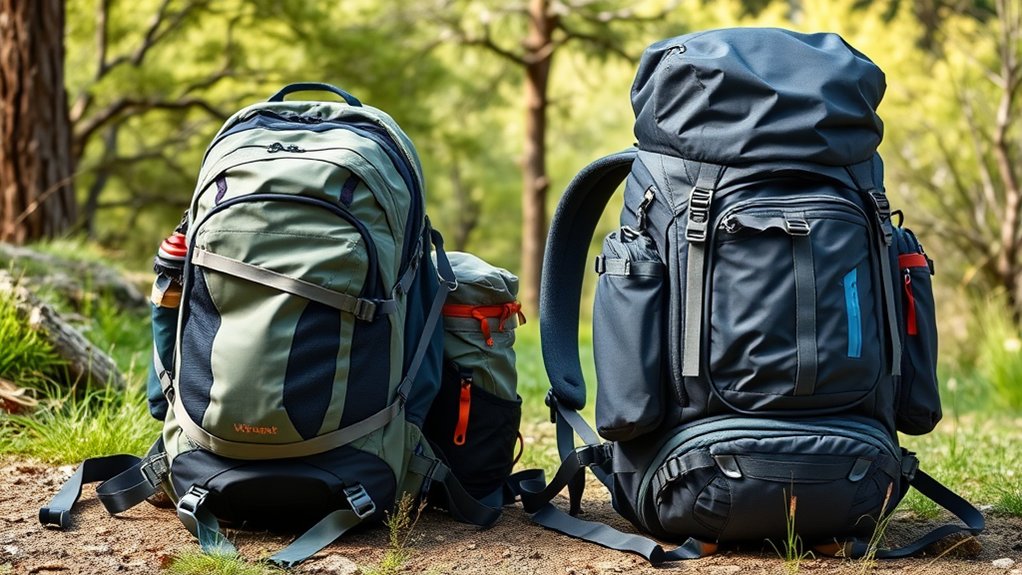
Gear selection marks one of the most significant differences between hiking and trekking adventures. While both activities require essential items like proper footwear and navigation tools, trekking demands a more thorough kit due to its extended nature and challenging terrains.
For hiking, you'll need reliable hiking shoes, navigation tools, and enough water for your planned route. Don't forget weather-appropriate clothing layers, a basic first-aid kit, and a headlamp for unexpected delays. A moisture-wicking layer ensures you stay dry and comfortable during physical exertion. The Nitecore NU25 offers simple, ultralight illumination that recharges via USB-C. Most day hikers choose 18-28 liter backpacks that provide adequate space for essentials.
You're also wise to pack sun protection, a multi-tool, and an emergency shelter, even for shorter journeys.
Trekking takes your gear needs to the next level. You'll require a sturdy tent, sleeping bag, and cooking equipment for those overnight stays in the wilderness.
Trekking poles become invaluable companions, helping you navigate difficult terrain while reducing strain on your joints. Your extended journey calls for an exhaustive emergency kit, including a survival lighter and signal whistle.
Pack extra food, a dedicated hydration system, and additional first-aid supplies. Remember, when you're days away from civilization, your gear isn't just about comfort – it's about survival.
Training and Experience
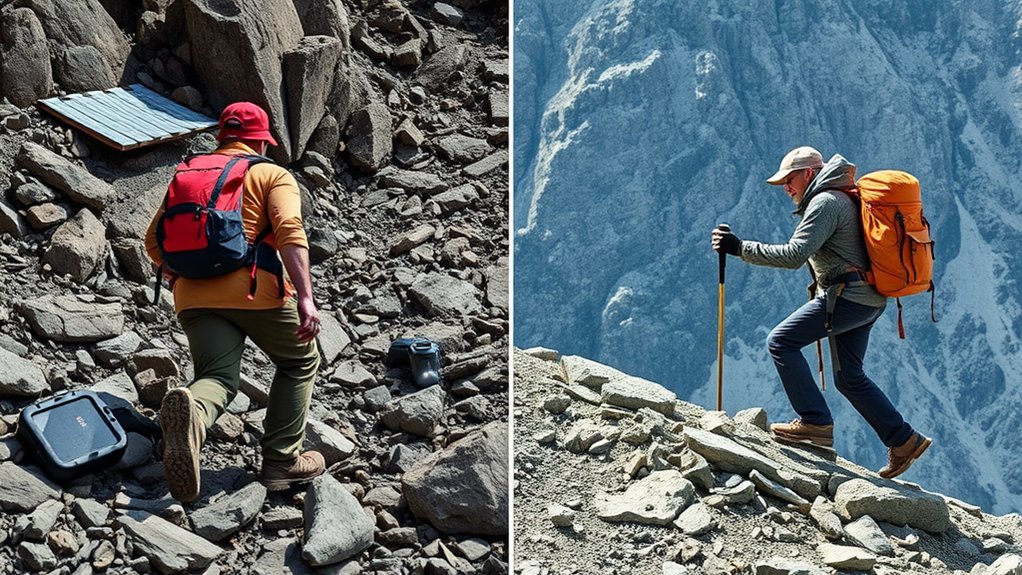
Just as having the right equipment prepares you for the trail, proper training and experience determine your readiness for hiking or trekking adventures. While you can start hiking with an average fitness level, trekking demands substantially more physical preparation and expertise. Regular stretching exercises can significantly reduce your risk of injury during both activities.
You'll need to focus on building endurance through consistent cardio workouts and strengthening specific muscle groups, particularly your glutes and legs. For trekking, you'll want to incorporate training with weighted packs to prepare for the heavier loads you'll carry on extended journeys. Understanding your hiking level is crucial for selecting appropriate training intensity and trail difficulty.
If you're new to outdoor adventures, start with hiking to build your foundational skills. As you progress, you'll develop vital abilities like map reading, compass navigation, and terrain evaluation. These skills become essential when you're ready to shift to trekking's more challenging demands.
Remember to train your mind as well as your body. You'll need mental resilience and quick decision-making abilities, especially during treks. Practice reading trail markers, evaluating weather conditions, and making safety-conscious choices.
Your ability to adapt to unexpected situations and maintain a positive mindset will prove invaluable on both hiking and trekking expeditions.
Planning Your Budget
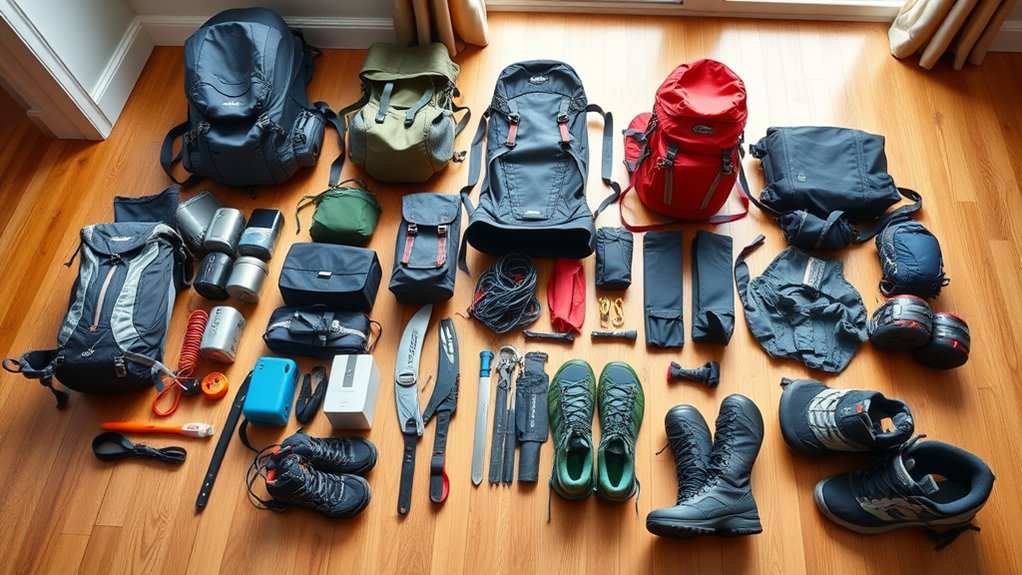
Successfully planning your adventure starts with understanding the financial commitment of hiking versus trekking. While day hiking requires minimal gear investment, trekking demands substantial financial preparation due to its extended duration and more challenging conditions.
Your initial gear expenses will set you back $1,000-$3,000, with the essential "Big Three" (backpack, tent, sleeping bag) accounting for most of that cost. Don't skimp on quality – your gear choices directly impact your safety and comfort on extended journeys.
For trekking, you'll need to budget $1,000-$1,500 monthly for on-trail expenses. You'll burn through 3,000-5,000 calories daily, costing $10-$15 per day for trail food alone.
Town visits add another $50-$75 per day to your expenses.
Factor in transportation to and from trailheads, occasional lodging, and emergency funds. Set aside money for gear replacement – you'll need new shoes and other consumables during longer treks.
Don't forget to budget for postage if you're planning resupply packages. Always maintain an emergency fund for unexpected situations, and consider setting aside post-trek funds to ease your shift back to regular life.
Conclusion
Whether you're scaling a mountain like a determined ant or taking a leisurely stroll through nature's gallery, you'll find your perfect outdoor match in hiking or trekking. They're like two branches of the same tree – one's a quick climb, the other's an epic journey. With 60% of outdoor enthusiasts starting with day hikes before advancing to treks, you're in good company whichever path you choose.

